
Mycalesis oculus, the red-disc bushbrown, is a satyrine butterfly found in southern India. It is similar in markings to Mycalesis adolphei but distinguished by the reddish band around the large apical spots on the upper forewings.
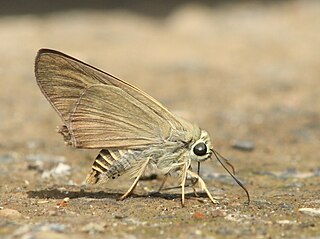
Badamia exclamationis, commonly known as the brown awl or narrow-winged awl, is a butterfly belonging to the family Hesperiidae. It is found in south and southeast Asia, Australia, and Oceania.

Bibasis gomata, commonly known as the pale green awlet, is a butterfly belonging to the family Hesperiidae. It is found in Northeast India, the Western Ghats and parts of Southeast Asia. The butterfly was reassigned to genus Burara by Vane-Wright and de Jong (2003) and is considered by them to be Burara gomata.
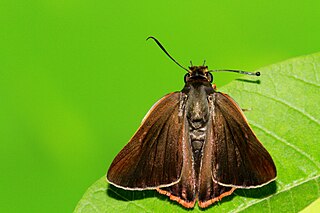
Bibasis sena, commonly known as the orange-tailed awlet, is a butterfly belonging to the family Hesperiidae, the skippers. It is also sometimes called the pale green awlet though that name can also refer to Bibasis gomata.

Cupitha purreea, commonly known as the wax dart, is a butterfly belonging to the family Hesperiidae and only species of the genus Cupitha.
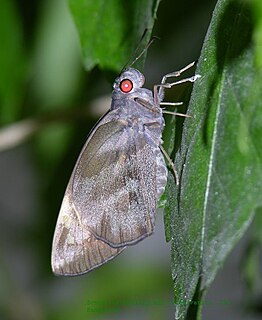
Gangara thyrsis, commonly known as the giant redeye, is a butterfly belonging to the family Hesperiidae. It breeds on a number of palm species.

Iambrix salsala, the chestnut bob, is a butterfly belonging to the family Hesperiidae, that is found in parts of South Asia and Southeast Asia.

Salanoemia sala, the maculate lancer, is a butterfly belonging to the family Hesperiidae found in India, Thailand, Laos and Vietnam.

Suastus gremius, the Indian palm bob or palm bob, is a butterfly belonging to the family Hesperiidae. It is found in the Indomalayan realm.
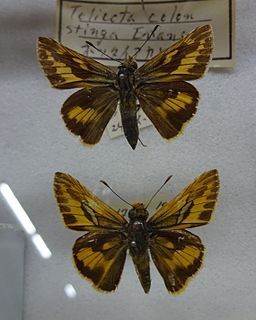
Telicota colon, commonly known as the pale palm dart or common palm dart, is a butterfly belonging to the family Hesperiidae found in India to Australia.

Hyarotis microstictum, the brush flitter, is a butterfly belonging to the family Hesperiidae. It is found in the Indomalayan realm and in South India. H. m. coorga Evans, 1949 is the subspecies found in South India. H. m. microstictum is the subspecies found in the Indomalayan realm.

Hasora anura, the slate awl, is a species of hesperid butterfly found in Asia. In India it is found in Sikkim and the Khasi Hills.

Gangara lebadea, the banded redeye, is a species of hesperid butterfly found in Southeast Asia.
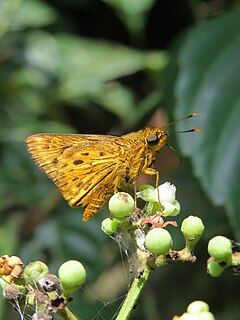
Thoressa honorei, commonly known as the Madras ace, is a skipper butterfly belonging to the family Hesperiidae found in south India.
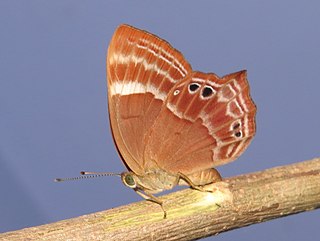
Abisara bifasciata, the double-banded Judy or twospot plum Judy, is a butterfly in the family Riodinidae. It is found in Asia.
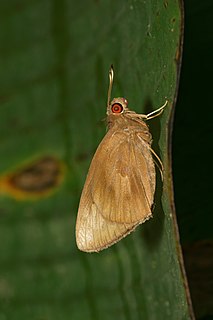
Erionota torus, the rounded palm-redeye, Sikkim palm dart, Sikkim palm red-eye and banana skipper, is a butterfly of the family Hesperiidae. It was described by William Harry Evans in 1941. It is found from southern and northeast India to Burma, Thailand, Laos, Vietnam, Malaysia, Singapore and China. It has also been recorded from Taiwan.
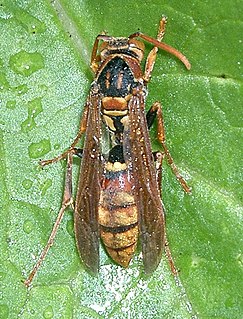
Polistes japonicus is a eusocial paper wasp found in Japan. It was first described by Henri Louis Frédéric de Saussure in 1858. It is closely related to Polistes formosanus. This species lives in small colonies with few workers and a foundress queen. Nests of these wasps are sometimes used as a traditional medicine in Korea, China, and Japan.

Ochus subvittatus, the tiger hopper, is the only species in the monotypic moth genus Ochus of the family Hesperiidae. The genus was erected by Lionel de Nicéville in 1894. The species was first described by Frederic Moore in 1878. It is found in the Khasi Hills and Naga Hills of India, Myanmar, Thailand, Laos, Vietnam and Yunnan.

Halpe zema, the zema banded ace, is a species of skipper, a butterfly belonging to the family Hesperiidae. It is native to Nepal, India, and Myanmar.

Pedesta pandita, the brown bush bob, is a species of skipper, a butterfly belonging to the family Hesperiidae. The species was first described by Lionel de Nicéville in 1885.
























